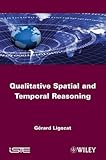Qualitative Spatial and Temporal Reasoning.
Material type: TextPublication details: London, UK : ISTE ; Hoboken, N.J. : Wiley, 2012.Description: 1 online resource (xxxi, 505 pages) : illustrationsContent type:
TextPublication details: London, UK : ISTE ; Hoboken, N.J. : Wiley, 2012.Description: 1 online resource (xxxi, 505 pages) : illustrationsContent type: - text
- computer
- online resource
- 9781118601372
- 1118601378
- 9781118601457
- 1118601459
- Qualitative reasoning
- Spatial analysis (Statistics)
- Space and time -- Mathematical models
- Logic, Symbolic and mathematical
- Space and time -- Mathematical models
- MATHEMATICS -- Infinity
- MATHEMATICS -- Logic
- Logic, Symbolic and mathematical
- Qualitative reasoning
- Space and time -- Mathematical models
- Spatial analysis (Statistics)
- 511.3
- Q339.25 .L54 2012
Print version record.
Includes bibliographical references.
Cover; Qualitative Spatial and Temporal Reasoning; Title Page; Copyright Page; Table of Contents; Introduction. Qualitative Reasoning; Chapter 1. Allen's Calculus; 1.1. Introduction; 1.1.1. "The mystery of the dark room"; 1.1.2. Contributions of Allen's formalism; 1.2. Allen's interval relations; 1.2.1. Basic relations; 1.2.2. Disjunctive relations; 1.3. Constraint networks; 1.3.1. Definition; 1.3.2. Expressiveness; 1.3.3. Consistency; 1.4. Constraint propagation; 1.4.1. Operations: inversion and composition; 1.4.2. Composition table; 1.4.3. Allen's algebra; 1.4.4. Algebraic closure.
1.4.5. Enforcing algebraic closure 1.5. Consistency tests; 1.5.1. The case of atomic networks; 1.5.2. Arbitrary networks; 1.5.3. Determining polynomial subsets; Chapter 2. Polynomial Subclasses of Allen's Algebra; 2.1. "Show me a tractable relation!"; 2.2. Subclasses of Allen's algebra; 2.2.1. A geometrical representation of Allen's relations; 2.2.2. Interpretation in terms of granularity; 2.2.3. Convex and pre-convex relations; 2.2.4. The lattice of Allen's basic relations; 2.2.5. Tractability of convex relations; 2.2.6. Pre-convex relations; 2.2.7. Polynomiality of pre-convex relations.
2.2.8. ORD-Horn relations 2.3. Maximal tractable subclasses of Allen's algebra; 2.3.1. An alternative characterization of pre-convex relations; 2.3.2. The other maximal polynomial subclasses; 2.4. Using polynomial subclasses; 2.4.1. Ladkin and Reinefeld's algorithm; 2.4.2. Empirical study of the consistency problem; 2.5. Models of Allen's language; 2.5.1. Representations of Allen's algebra; 2.5.2. Representations of the time-point algebra; 2.5.3. [aleph-null] categoricity of Allen's algebra; 2.6. Historical note; Chapter 3. Generalized Intervals; 3.1. "When they built the bridge."
3.1.1. Towards generalized intervals 3.2. Entities and relations; 3.3. The lattice of basic (p, q)-relations; 3.4. Regions associated with basic (p, q)-relations; 3.4.1. Associated polytopes; 3.4.2. M-convexity of the basic relations; 3.5. Inversion and composition; 3.5.1. Inversion; 3.5.2. Composition; 3.5.3. The algebras of generalized intervals; 3.6. Subclasses of relations: convex and pre-convex relations; 3.6.1. (p, q)-relations; 3.6.2. Convex relations; 3.6.3. Pre-convex relations; 3.7. Constraint networks; 3.8. Tractability of strongly pre-convex relations; 3.8.1. ORD-Horn relations.
3.9. Conclusions 3.10. Historical note; Chapter 4. Binary Qualitative Formalisms; 4.1. "Night driving"; 4.1.1. Parameters; 4.1.2. A panorama of the presented formalisms; 4.2. Directed points in dimension 1; 4.2.1. Operations; 4.2.2. Constraint networks; 4.2.3. Networks reducible to point networks; 4.2.4. Arbitrary directed point networks; 4.3. Directed intervals; 4.3.1. Operations; 4.3.2. Constraint networks and complexity; 4.4. The OPRA direction calculi; 4.5. Dipole calculi; 4.6. The Cardinal direction calculus; 4.6.1. Convex and pre-convex relations; 4.6.2. Complexity; 4.7. The Rectangle calculus.
Starting with an updated description of Allen's calculus, the book proceeds with a description of the main qualitative calculi which have been developed over the last two decades. It describes the connection of complexity issues to geometric properties. Models of the formalisms are described using the algebraic notion of weak representations of the associated algebras. The book also includes a presentation of fuzzy extensions of qualitative calculi, and a description of the study of complexity in terms of clones of operations.
